Greenpeace: China's Air Pollution Thins Out but Beijing Still Most Polluted
| Ana Verayo | | Apr 22, 2015 10:04 AM EDT |
(Photo : AP) This photo shows the severe air pollution in Beijing.
Recent reports reveal data from the Chinese government shows the air pollution looming over Beijing decreased significantly during this first quarter of the year compared to last year's first quarter.
Environmental protection organization Greenpeace also confirms the particulate matter (PM2.5) found in China's capital fell by as much as 13 percent during the first three months this 2015 as opposed to 2014's first quarter.
Like Us on Facebook
This particulate matter, PM 2.5, is a unit used to measure pollution found in an area where 2.5 represents 2.5 micrometers or less. Highly dangerous to humans, this material can penetrate the body and invade the lungs and enter the bloodstream.
According to Zhang Kai from Greenpeace East Asia in Beijing, this significant decrease in pollution can be attributed to the Chinese government's efforts that have been effective in curbing air pollution levels across the nation. Pollution levels in industrial areas were also reduced, especially in Beijing and provincial neighbor, Hebei.
This new Greenpeace study also reveals that among the 74 cities observed and monitored last year, some cities have shown improvements by presenting an average 48 percent decrease in air pollution. Hebei, which is also one of the main contributors of air pollution in Beijing, registered a 32 percent decrease in PM2.5 levels.
Greenpeace still notes that while the decrease of air pollution in the capital is apparent, Beijing is still considered one of the most polluted cities in China. The organization still believes the air quality in the city remains a health hazard for locals.
Researchers from Greenpeace East Asia have analyzed the air pollution levels in 367 Chinese cities and completed a ranking according to their amount of particulate matter based on data from China's Ministry of Environmental Protection.
The findings showed that out of all the cities monitored and analyzed, 360 cities had a PM2.5 concentration of 66 micrograms per cubic meter, which is twice from the standard of 35 micrograms per cubic meter for the whole nation.
This result was also twice the amount of the exposure limit of 25 micrograms per cubic meter during a period of 24 hours, according to the World Health Organization.
TagsGreenpeace: China's Air Pollution Thins Out But Beijing Still the Most Polluted, Greenpeace, air pollution china, air pollution beijing
©2015 Chinatopix All rights reserved. Do not reproduce without permission
EDITOR'S PICKS
-

Did the Trump administration just announce plans for a trade war with ‘hostile’ China and Russia?
-

US Senate passes Taiwan travel bill slammed by China
-

As Yan Sihong’s family grieves, here are other Chinese students who went missing abroad. Some have never been found
-

Beijing blasts Western critics who ‘smear China’ with the term sharp power
-

China Envoy Seeks to Defuse Tensions With U.S. as a Trade War Brews
-

Singapore's Deputy PM Provides Bitcoin Vote of Confidence Amid China's Blanket Bans
-

China warns investors over risks in overseas virtual currency trading
-

Chinese government most trustworthy: survey
-

Kashima Antlers On Course For Back-To-Back Titles
MOST POPULAR
LATEST NEWS
Zhou Yongkang: China's Former Security Chief Sentenced to Life in Prison

China's former Chief of the Ministry of Public Security, Zhou Yongkang, has been given a life sentence after he was found guilty of abusing his office, bribery and deliberately ... Full Article
TRENDING STORY

China Pork Prices Expected to Stabilize As The Supplies Recover

Elephone P9000 Smartphone is now on Sale on Amazon India

There's a Big Chance Cliffhangers Won't Still Be Resolved When Grey's Anatomy Season 13 Returns

Supreme Court Ruled on Samsung vs Apple Dispute for Patent Infringement

Microsoft Surface Pro 5 Rumors and Release Date: What is the Latest?










